Two
PLACE
In 1876, the chief of the Revenue Cutter Bureau, Summer I. Kimball, established the first academy, known as the Revenue Cutter School of Instruction, afloat on the revenue cutter Dobbin with eight cadets and three instructors. Kimball had long been dissatisfied with the system of the politically based appointment of revenue cutter (R/C) officers. He felt that aspiring officers should have a deep interest in and enthusiasm for a life at sea and that the best way to learn seamanship and navigation was to have them spend extended periods afloat with competent instructors. The Dobbin, with its crew and eight cadets, sailed on its first practice cruise on May 24, 1877. Among the cadets—and one of the first to get seasick—was Worth G. Ross, who later became the commandant of the Coast Guard.
The new R/C Salmon P. Chase relieved the Dobbin in 1878. Like the Dobbin, the Chase had her homeport in New Bedford. The Chase was named after Abraham Lincoln’s secretary of the treasury, Salmon Portland Chase, and had been specifically designed by Kimball to be a training ship for a dozen cadets. In 1895, the ship was dry-docked, cut in half, and lengthened by 40 feet to enable her to accommodate 25 cadets. Between 1890 and 1894, the school was suspended, with all the officers for the Revenue Cutter Service coming from the Naval Academy at Annapolis due to a surplus of graduates from that academy.
In 1900, the School of Instruction of the Revenue Cutter Service came ashore when it moved into a building at Curtis Bay. The corps of cadets at the time had 40 members, and the faculty had seven instructors. The Chase remained a training ship from 1878 until she was replaced by the R/C Itasca, a former Navy training ship, in 1907. At 190 feet, the Itasca was a barquentine-rigged cutter. In addition to the sails, the Itasca had modern equipment and a triple-expansion steam engine. The Itasca was replaced in 1922 with the R/C Alexander Hamilton, which remained the training ship until 1930.
In 1910, the school that was to become the US Coast Guard Academy moved to the New London, Connecticut, area when the War Department turned over to the service the historic Fort Trumbull located on the banks of the Thames River. Parts of Fort Trumbull dated back to the Revolutionary War and left much to be desired.
One year before its move, the academy’s curriculum was increased to four years to make it compatible with West Point and Annapolis. The academy left Fort Trumbull in 1932 and moved to its current location on 100 acres of land, obtained from the City of New London, on the west bank of the Thames River.
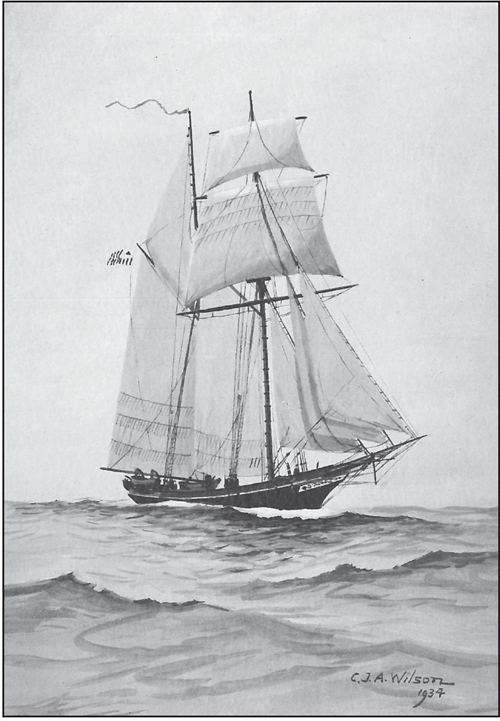
THE TOPSAIL SCHOONER R/C DOBBIN. This was the first home of the Revenue Cutter School of Instruction in 1876. Named for Pres. Franklin Pierce’s secretary of the navy, James Cochrane Dobbin, the Dobbin had a length of 93 feet, 9 inches; a beam of 22 feet, 6 inches; and drew 9 feet, 9 inches, of water. She had a complement of 13 officers and men. (Donald Canney, US Coast Guard and Revenue Cutters, 1790–1935, Annapolis: Naval Institute Press, 1995.)

R/C SALMON P. CHASE. This was the home of the Revenue Cutter School of Instruction beginning in 1878. The cutter was specifically built for the corps of cadets. Named for Pres. Abraham Lincoln’s secretary of the treasury, the Chase was 115.4 feet long until 1895, when the vessel was cut in two and 40 feet were added to its length to make more room for cadets. The Chase had a beam of nearly 25 feet and a draft of 12 feet. (Donald Canney, US Coast Guard and Revenue Cutters, 1790–1935, Annapolis: Naval Institute Press, 1995.)
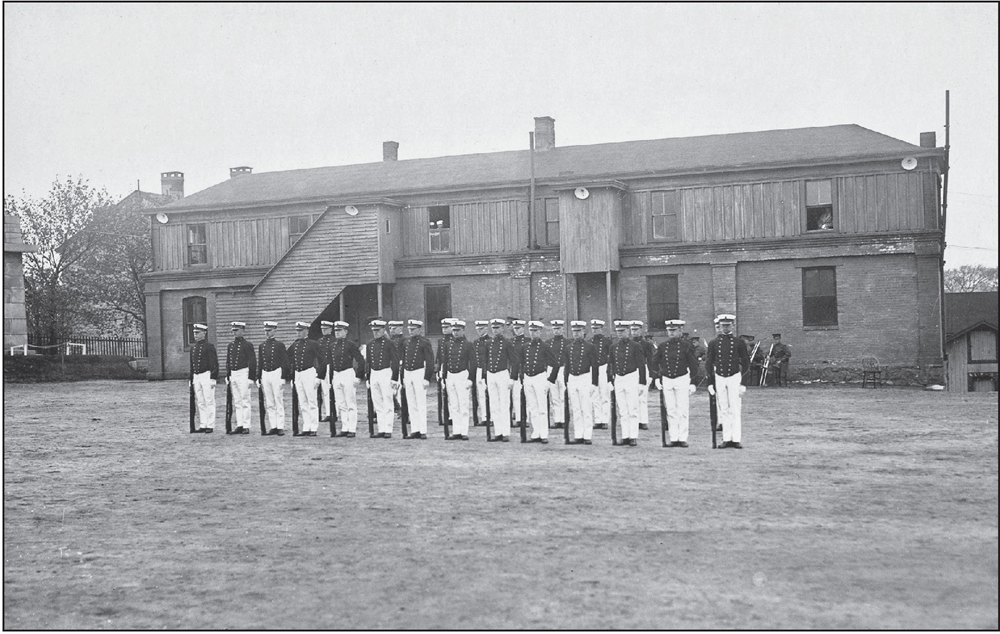
CADETS AT FORT TRUMBULL. In 1910, the War Department turned over Fort Trumbull to the Revenue Cutter Service, and the Revenue Cutter School of Instruction was located here until it was moved to its current location in 1932. Many of the fort’s buildings were constructed in the days of the Revolutionary War, and their age was apparent. (1935 Tide Rips.)
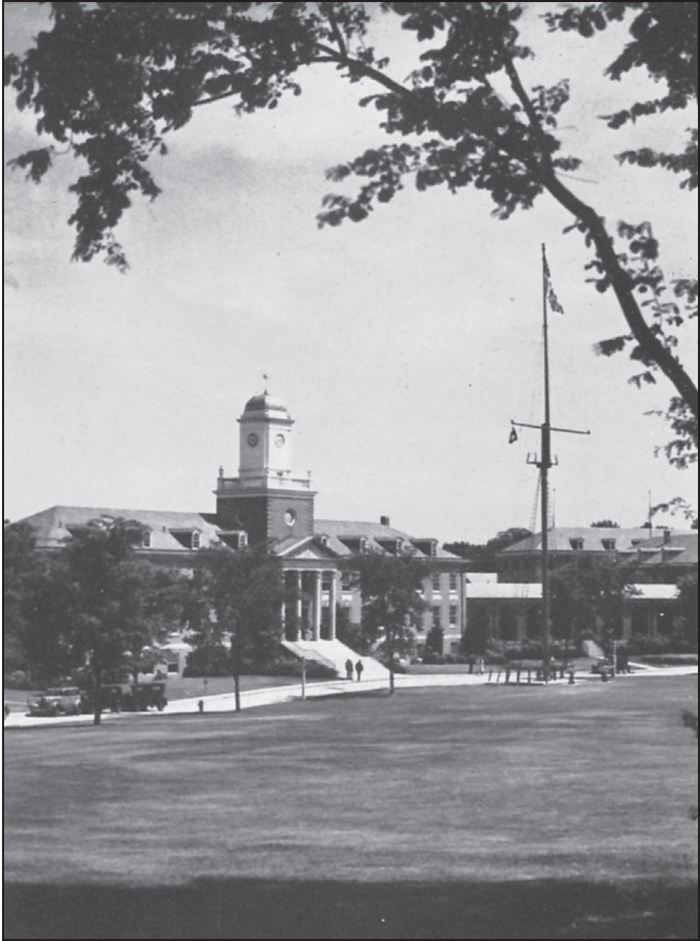
EARLY PICTURE OF THE US COAST GUARD ACADEMY. While it was located at Fort Trumbull, the school was renamed the US Coast Guard Academy when the Revenue Cutter Service was merged with the Life-Saving Service to become the US Coast Guard in 1915. The beautiful campus of the early academy was a major step up as a home for the cadets. (1940 Tide Rips.)
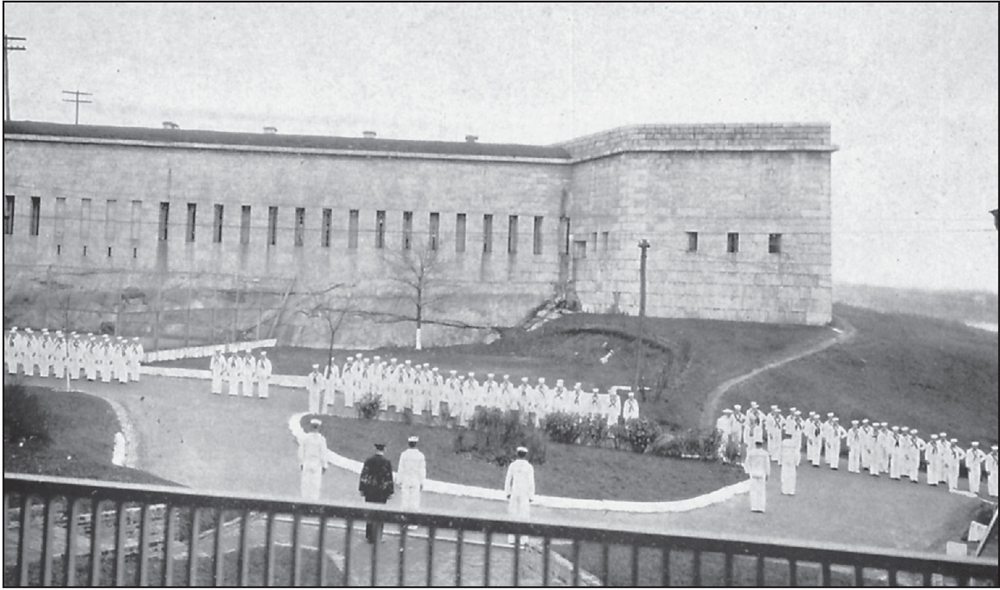
CADETS IN FORMATION AT FORT TRUMBULL. These cadets in formation are wearing traditional white sailor uniforms. The fort’s buildings were dated and inappropriate for a modern university. When the Revenue Cutter School moved into the fort in 1910, the buildings were already 71 years old. (Courtesy of Public Affairs, Commandant US Coast Guard.)
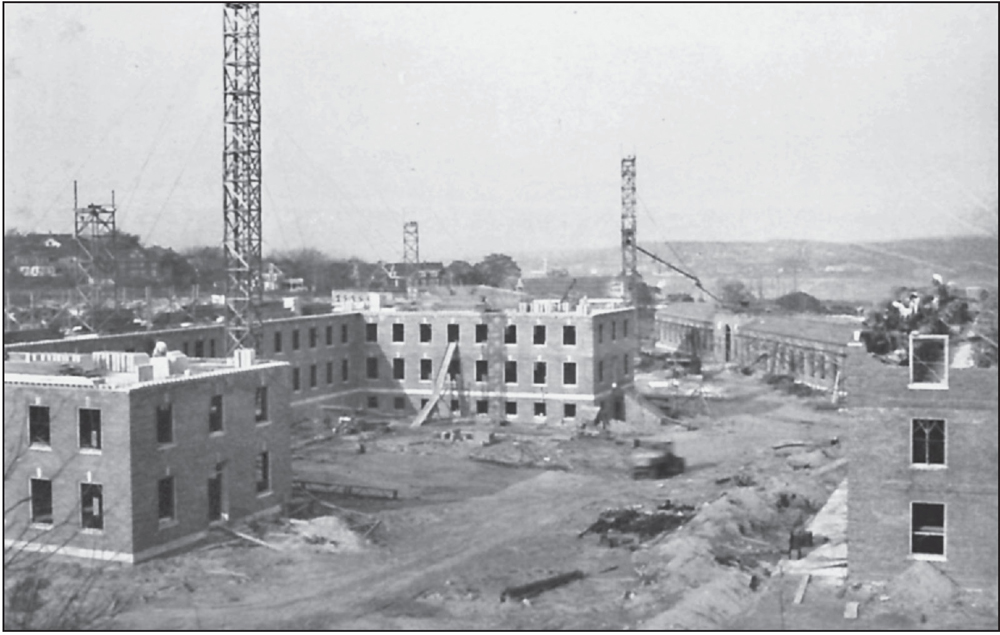
THE ACADEMY UNDER CONSTRUCTION. This view looks north along what would become Campbell Street. The large building on the left is Satterlee Hall, named for Capt. Charles Satterlee (class of 1898). Satterlee was the commanding officer of the cutter Tampa, which was sunk by the German submarine U-35 in World War I. (Courtesy of US Coast Guard Academy Facilities Engineering.)
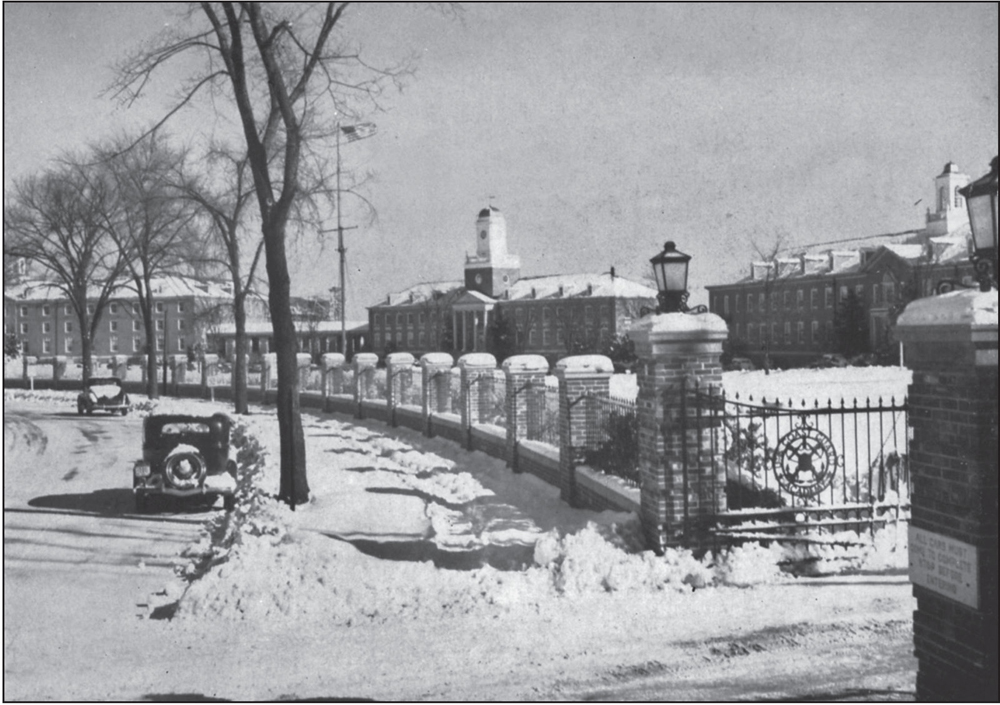
WINTER OF 1942. The large building to the left is Chase Hall, where cadets lived. It is named for Salmon P. Chase, who served as secretary of the treasury and, later, as chief justice of the Supreme Court. The middle building (with the columns) is Hamilton Hall, the original home of the library and the administrative offices. The superintendent has his office here. The building to the right is Satterlee Hall, where classes are held. (1942 Tide Rips.)
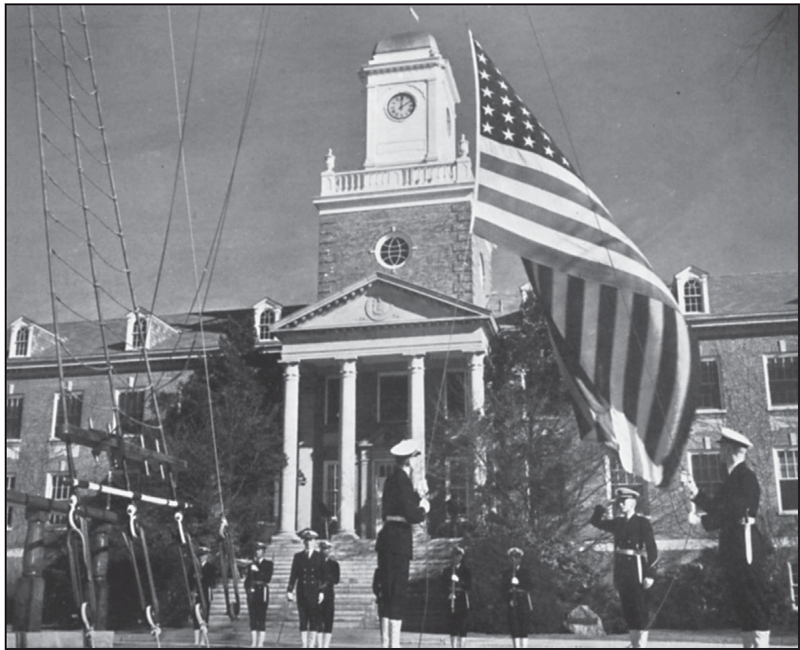
CADETS HOLD COLORS IN FRONT OF HAMILTON HALL. This ceremony is performed every morning and evening. In addition to the national flag, the superintendent’s flag is flown whenever he is in residence. The large flagpole was built as a replica of the mast on the cadet-training cutter Alexander Hamilton. (1933 Tide Rips.)
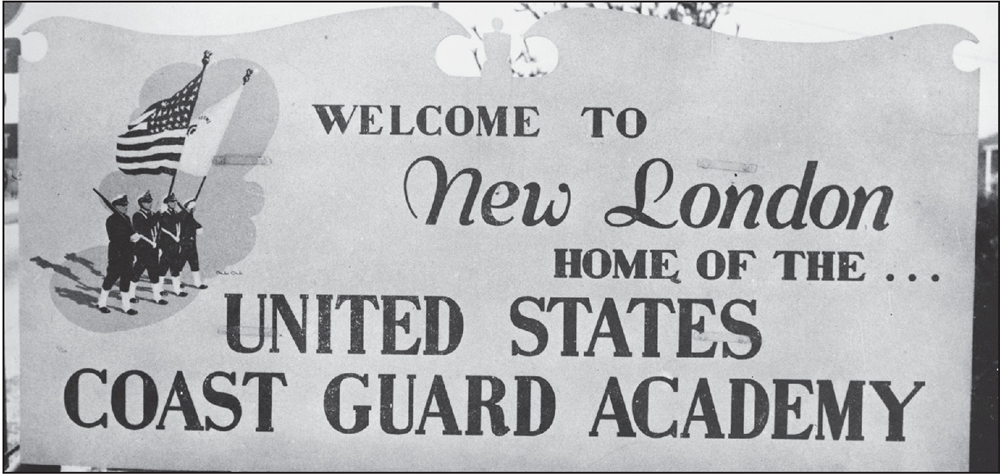
NEW LONDON SIGN. The city of New London proudly proclaims itself as the home of the US Coast Guard Academy. The academy has been in the New London area since 1910, when it was located at Fort Trumbull. It was moved to its current site in 1932. (1961 Tide Rips.)
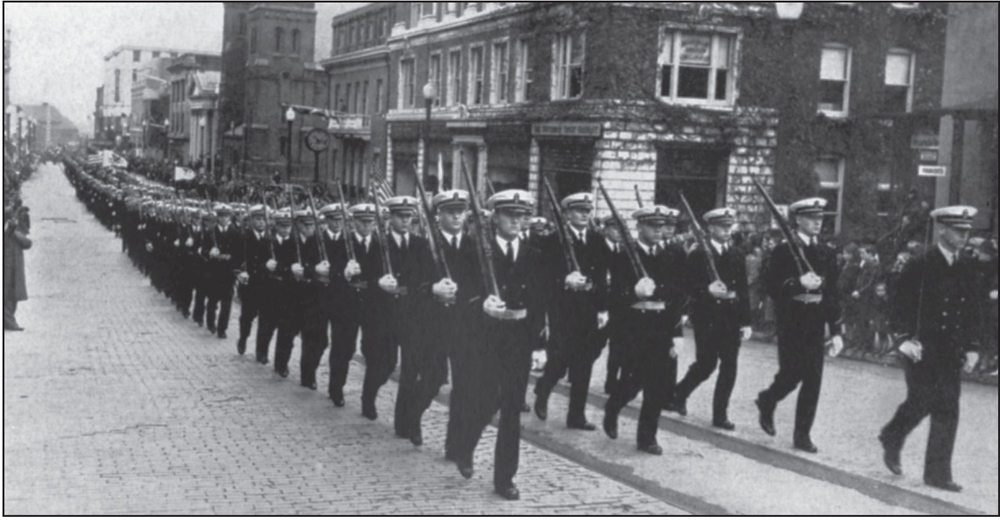
CADETS MARCHING IN DOWNTOWN NEW LONDON, 1941. Classes graduated after three years during World War II. The academy expanded considerably during the war years. The Coast Guard was transferred into the US Navy during the war. The Tide Rips yearbooks during the war years accordingly had a picture of the Chief of Naval Operations as the service head of the Coast Guard. (1942 Tide Rips.)

OLDER BARRACKS, KNOWN AS “SPLINTER VILLAGE.” The class of 1963 members in the Second Battalion lived in these relics from World War II. The Chase Hall expansion was completed in 1965. Since that time, all cadets have lived in Chase Hall. (Courtesy of Steve Ulmer.)
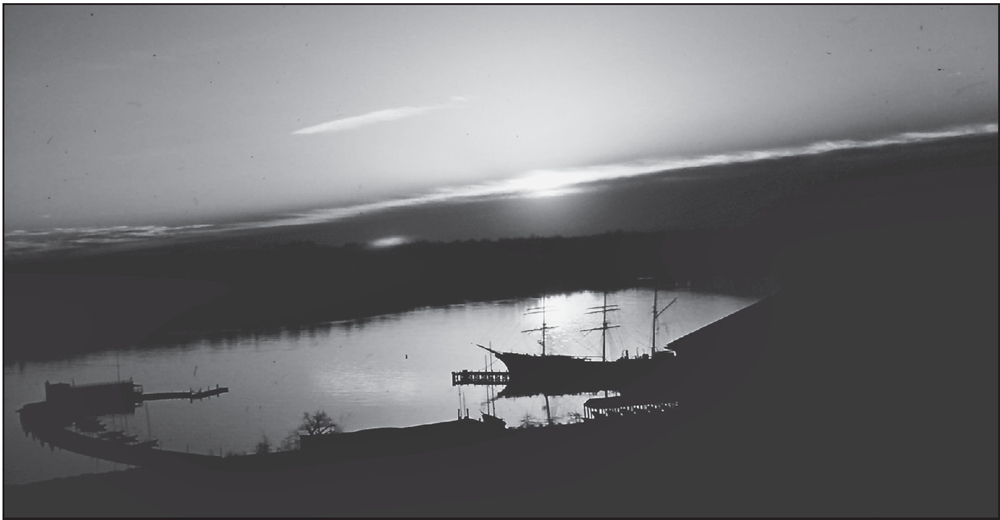
ACADEMY WATERFRONT SHOWING THE USCGC EAGLE. Jacobs Rock, home of the sailing activities of the academy, is a prominent spot. The Thames River is a beautiful location. The large Navy submarine base is located just upriver from the academy. During the author’s four years at the academy, a cadet in one of the school’s yachts made a submarine back down due to the rules of the road, which give right of way to sail over power. The cadet was subsequently given a class-one offense for embarrassing the submarine crew. (Courtesy of Steve Ulmer.)
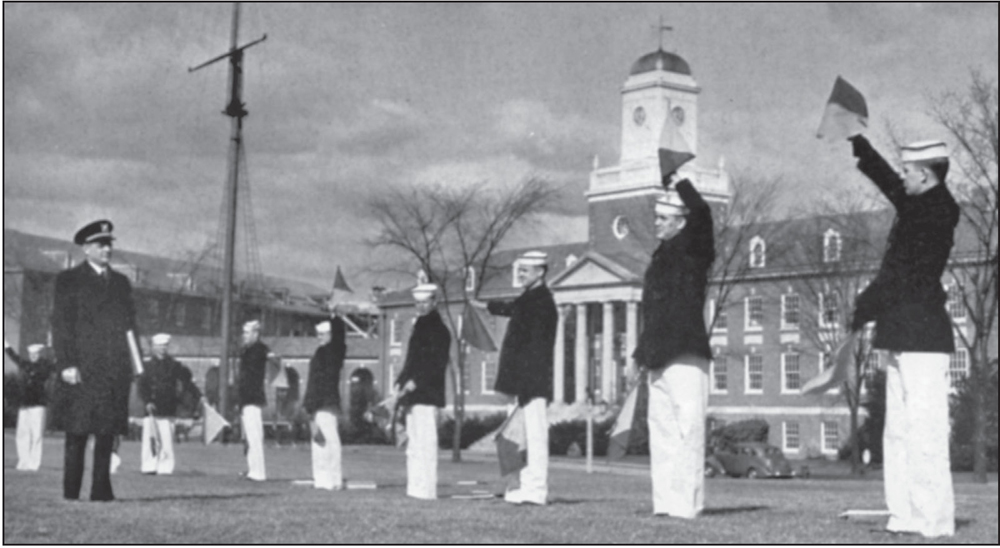
CADETS PRACTICE SEMAPHORE ON WASHINGTON PARADE GROUND. The World War II years saw many changes at the academy. Not only were there changes to the curriculum, but many physical changes were also necessary to handle the large number of reserve officers passing through. (1942–1943 Tide Rips.)
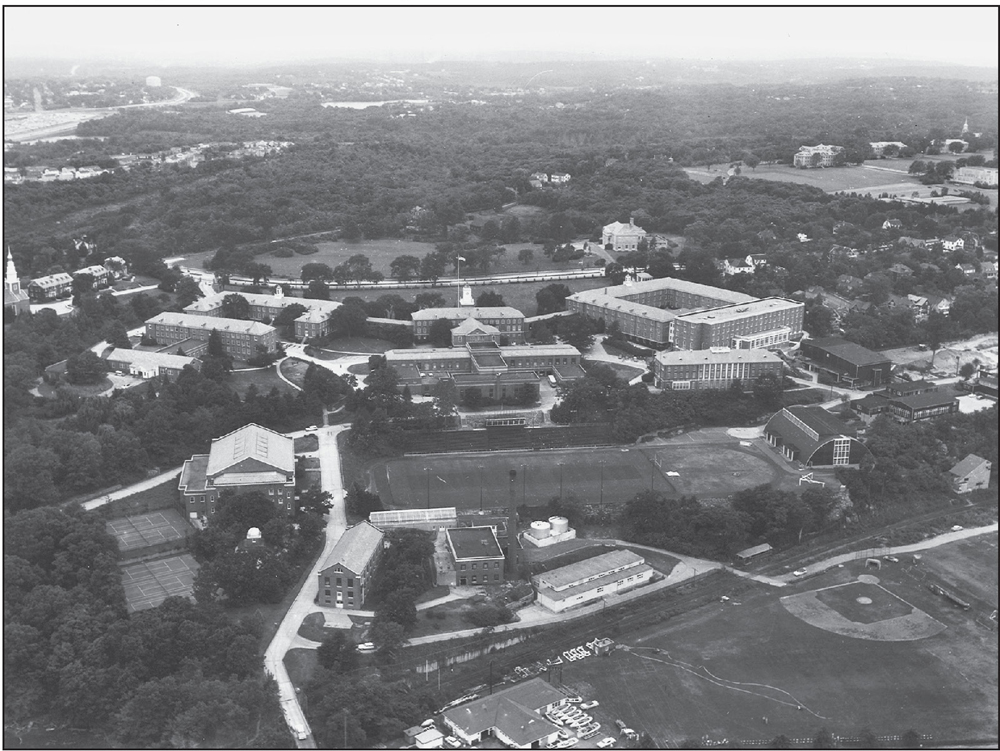
THE ACADEMY IN THE 1950S. Note the absence of Roland Hall, Leamy Hall, the Alumni Center, and the press box for Jones Field. Smith Hall, the new library, and Dimick Hall were yet to be constructed. (Courtesy of US Coast Guard Academy Facilities Engineering.)
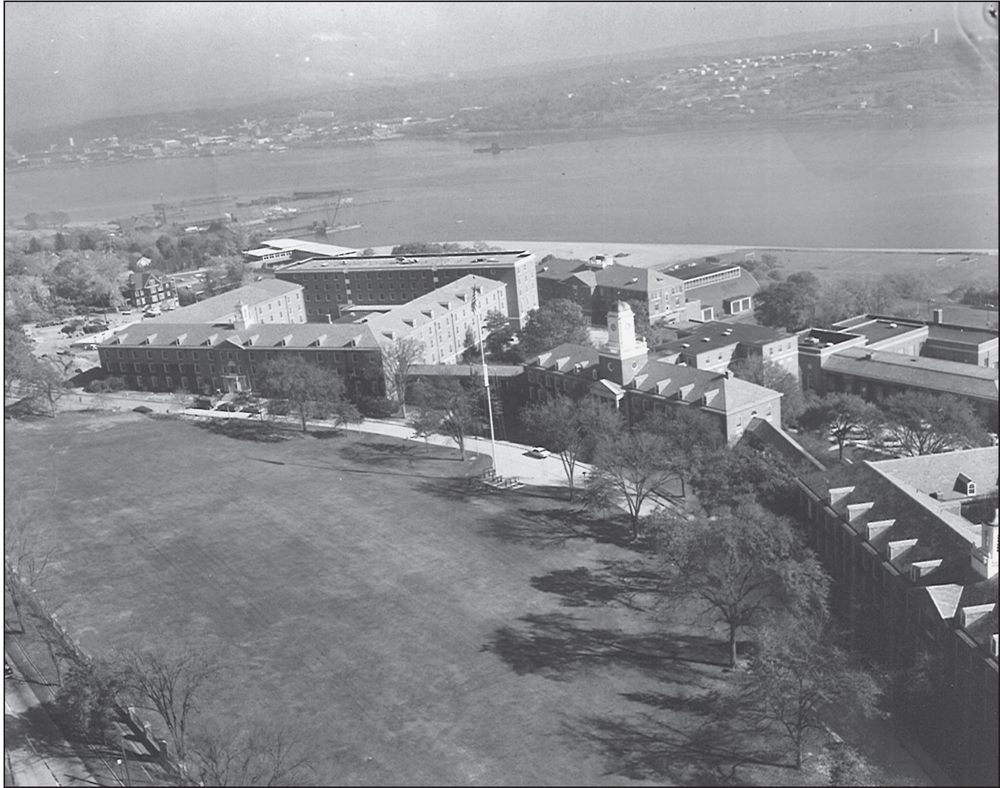
LOOKING NORTH TOWARD THE ACADEMY. In the center of this picture is the old fieldhouse, which was later torn down and replaced by the Alumni Center. The lower athletic practice fields have been greatly expanded since this photograph was taken. (Courtesy of US Coast Guard Academy Facilities Engineering.)
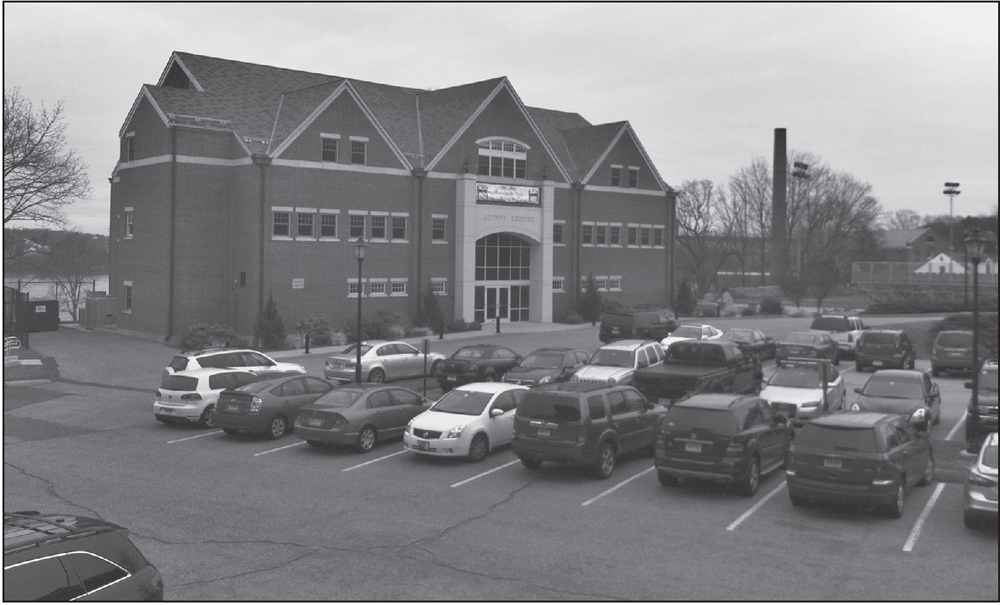
US COAST GUARD ACADEMY ALUMNI CENTER. The construction of the Alumni Center was funded by donations from alumni and sponsors. The third deck houses the Leadership Center and a boxing ring. (Author’s collection.)

RIBBON-CUTTING CEREMONY AT THE ALUMNI CENTER, 2005. Handling the scissors is Rear Adm. Paul Busick (class of 1966), US Coast Guard (retired), who was the chair of the alumni association at the time of this ceremony. Paul had an older brother, Pete, who was a member of the class of 1963. Looking on is the superintendent of the academy, Rear Adm. Jim Van Sice (second from left; class of 1974). (Courtesy of the US Coast Guard Academy Alumni Association.)

CLASS RING CABINET IN ALUMNI CENTER. This cabinet was created by Capt. Harvey Orr, US Coast Guard (retired). Captain Orr (class of 1963) also made the small table next to the cabinet. These items were alumni gifts nine and ten. At the time of the first gifts, which were given in 2005 and 2006, the then-president of the alumni association, Comdr. Jim Sylvester (class of 1971), said that Orr’s creations were instrumental in “bringing our alumni center to life.” Captain Orr was awarded the Distinguished Service Award from the US Coast Guard Academy Alumni Association in 2007. (Author’s collection.)

THE ATHLETIC FIELDHOUSE. Indoor track and spring football practice were held here. Otto Graham would often demonstrate his passing ability by standing at one end of the basketball court in the building and throwing the football through the basket at the other end. This building was torn down to make room for the Alumni Center. (Courtesy of Steve Ulmer.)
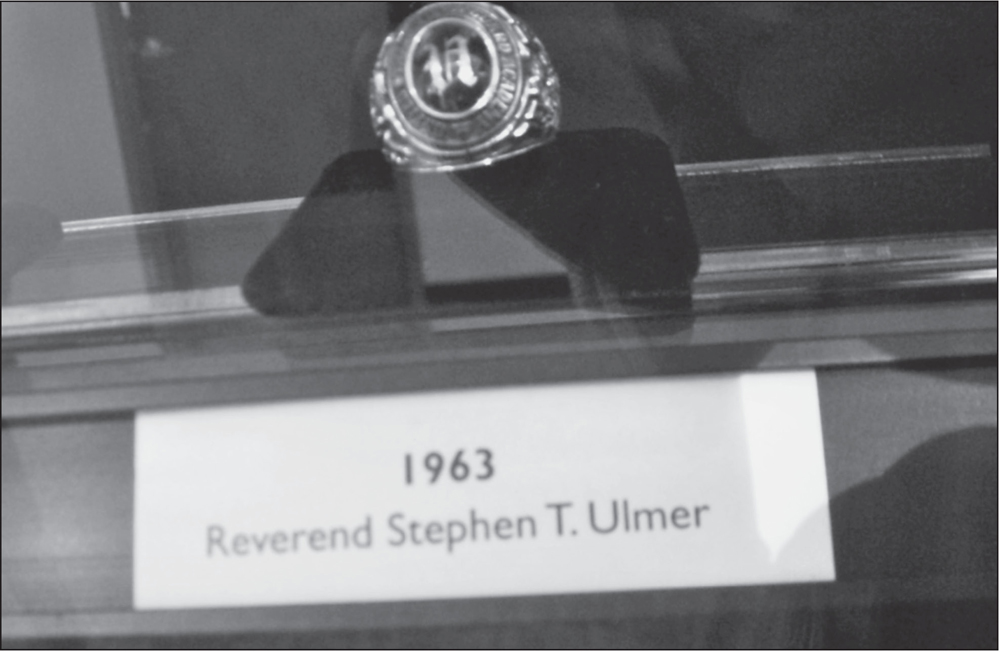
A 1963 CLASS RING IN THE RING DISPLAY CABINET. Cadets normally receive two rings. A miniature of the large ring is worn in the second-class year and replaced in the first-class year by the larger one, which the second class receives in April. Through the Golden Legacy Program sponsored by the alumni association, these rings are infused with the melted gold of class rings donated by alumni, connecting the Long Blue Line in a tangible way. This ring is a cadet’s symbol of their alma mater and can be worn for the rest of his or her life. Each ring bears the academy crest on one side and the individual’s class crest on the other. The class of 1963 had a controversial class crest, as it portrayed bare-chested mermaids holding a ship’s helm. This ring worn by Rev. Steve Ulmer was gifted to the Alumni Center for it to be put on display. (Author’s collection.)
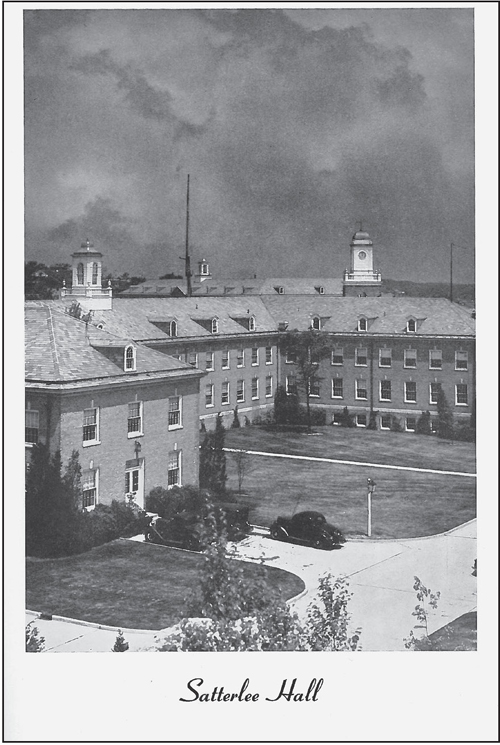
BACK ENTRANCE OF SATTERLEE HALL. This building was named after Capt. Charles Satterlee (class of 1898), who was the commanding officer of the USCGC Tampa, which was sunk by submarine torpedo on September 25, 1918, resulting in the loss of all hands. The Tampa had just safely escorted a convoy and was on its way home. Located in Satterlee Hall are the departments of leadership and development, mathematics, and humanities. (1940 Tide Rips.)

ACADEMY LIBRARY IN THE HENRIQUES BUILDING. The Henriques Building was named for Capt. John Henriques, who served at the Revenue Cutter School of Instruction from 1876 to 1883. The murals on the walls were painted as part of the Works Progress Administration. The library was later moved to its present location in Waesche Hall. (1950 Tide Rips.)
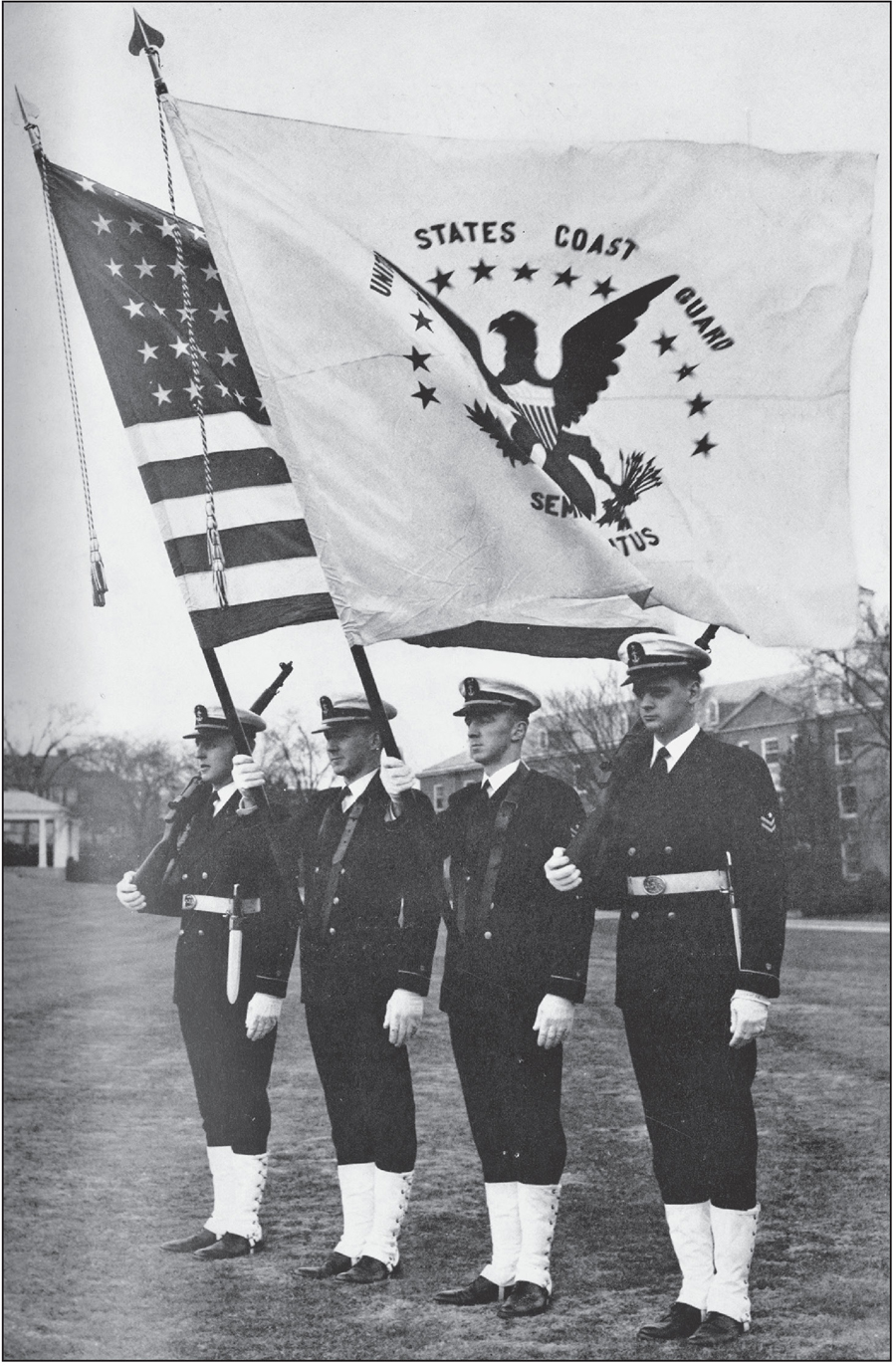
COLOR GUARD PREPARES FOR A REVIEW OF CORPS OF CADETS ON WASHINGTON PARADE GROUND. Reviews are frequently held on Saturday mornings before liberty is granted. They are also held on special weekends, such as Parents’ Weekend, Homecoming, and Graduation Week, and whenever there is a distinguished visitor at the academy. (1952 Tide Rips.)
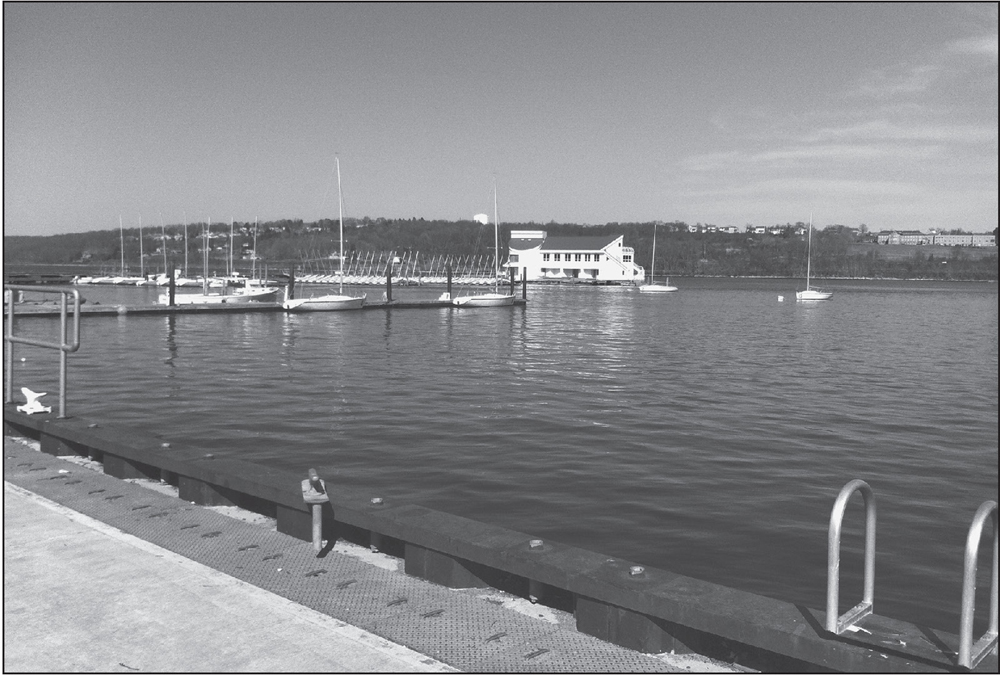
JACOBS ROCK. The home of the sailing center and the academy’s competitive sailing program is on Jacobs Rock. More than 100 cadets participate in the program and its junior varsity sailing team. The academy has had several national champions, and the 2019 Bears offshore team finished second overall in the National Collegiate Large Yacht Championship for the John F. Kennedy Memorial Trophy. (Author’s collection.)
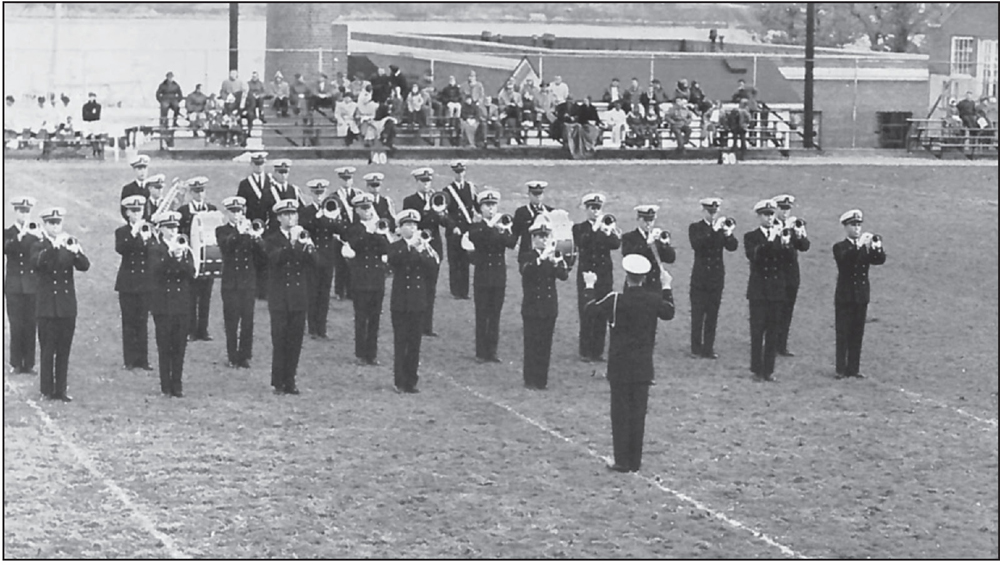
CADET MARCHING BAND. The academy has an extensive music program, including two marching bands, a concert band, a pep band, a jazz band (the Nite-Caps), the Windjammer Drum and Bugle Corps, and singing groups (the Glee Club, Fair Winds, and Idlers). (1954 Tide Rips.)
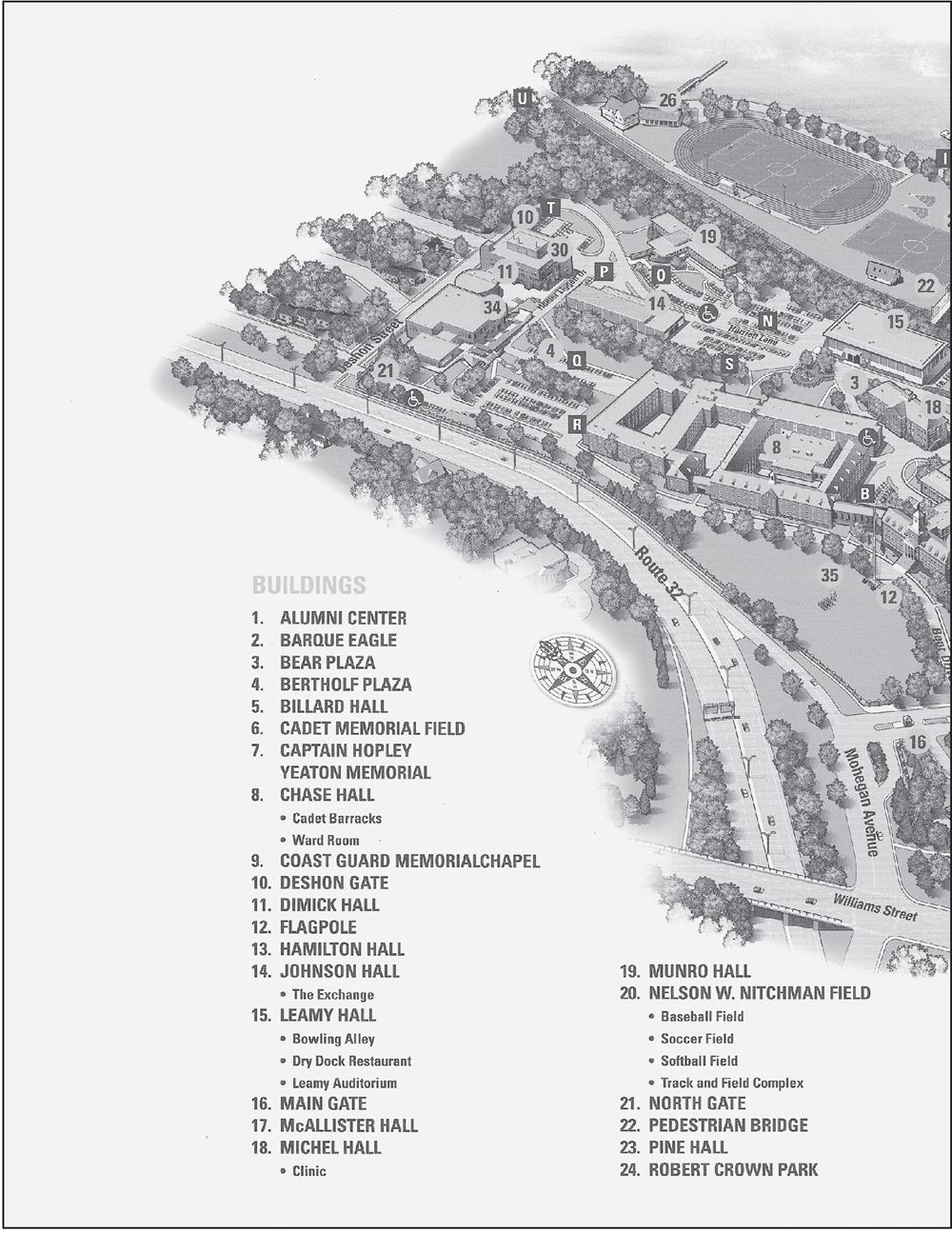
NORTHERN HALF OF THE ACADEMY. This map shows building locations and street names on the northern half of the campus. Building numbers are explained in the legend. (Courtesy of the US Coast Guard Academy Alumni Association.)

SOUTHERN HALF OF THE ACADEMY. This map shows building locations and street names on the southern half of the campus. Building numbers are explained in the legend. (Courtesy of the US Coast Guard Academy Alumni Association.)

THE USCGC EAGLE. Built in Germany in 1936, the Eagle was a World War II war prize and became a part of the academy in 1946. Her length is 295 feet with a beam of 39 feet. The fore and main masts are 150 feet tall, and she carries 22 sails with a total of 21,350 square feet of canvas. The Eagle hosts 70,000 to 80,000 visitors each year. In 2018, the alumni association funded nearly $250,000 in improvements to the Eagle. (Author’s collection.)

BASEBALL GAME. At this game held in the 1960s, the Eagle is moored in the background. The lower field has been renamed the Nelson W. Nitchman Field in honor of physical education instructor and coach “Nels” Nitchman, who was an assistant football coach at the academy from 1942 to 1945 and head coach from 1946 to 1958, when he was succeeded by Otto Graham. Nitchman also coached basketball at the academy from 1942 to 1954. (1966 Tide Rips.)
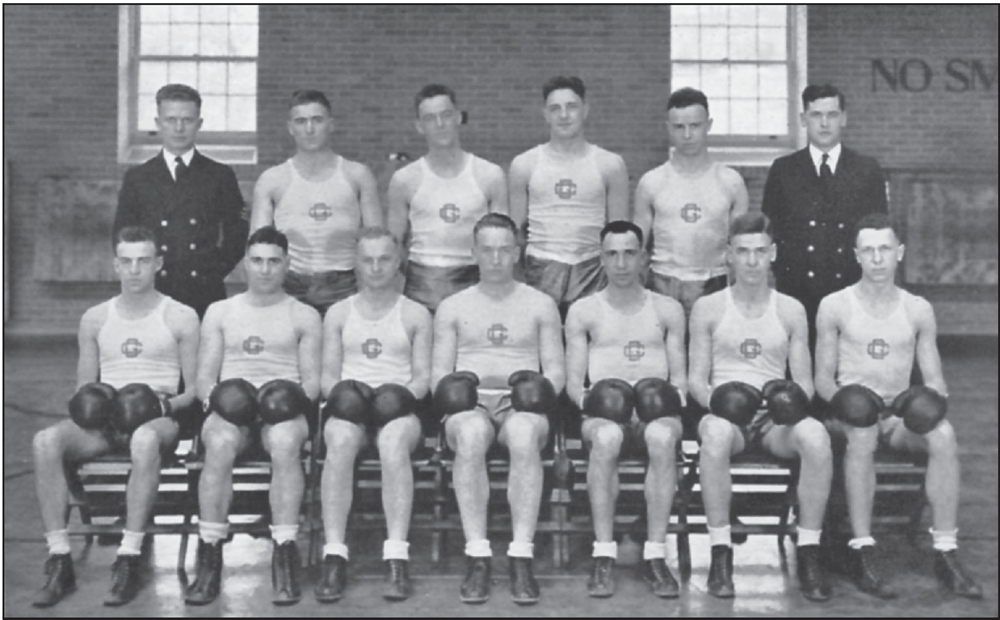
ACADEMY BOXING TEAM. Boxing was one of the earliest sports at the Revenue Cutter School of Instruction because it required little expensive equipment and taught self-defense. The sport was off and on over the years based on the periodic lack of a coach. In 2017, the academy boxing coach, Tom Barlie, was named the National Collegiate Boxing Association Coach of the Year. He left the academy in 2018 for another position, and the sport was shut down by the administration due to the lack of a coach and for safety reasons. (1940 Tide Rips.)

TRAINING BOATS (T-BOATS). T-Boats are used for ship-handling training. The boats are 65 years old and are named Honor, Respect, and Duty. The majority of cadet ship-handling training is done on the Ship Control and Navigation Training Systems (SCANTS) in Yeaton Hall. The ship simulators provide great experiences in ship-handling under various conditions, but there is something special about maneuvering an actual vessel and coordinating the actual docking of a ship. (Courtesy of the US Coast Guard Academy Alumni Association.)

WINTER SCENE, 1960S. This picture shows the old fieldhouse as well as the Eagle and Jacobs Rock on the waterfront. The Eagle is pictured without its distinctive speed stripe. The ship is no longer moored at the academy. (Courtesy of Steve Ulmer.)

CADET MEMORIAL CHAPEL. Located on the highest point at the academy, the chapel was built in 1952 thanks to donated funds. Incorporated in its design are symbols of the sacrifices of Coast Guard members, including the lectern dedicated to the memory of the USCGC Escanaba, which lost all but 2 of its 103 crew members in World War II. Attendance at religious services was mandatory during the four years the author attended the academy (from 1959 to 1963). The lighthouse beacon in the chapel steeple can be seen from great distances. (1959 Tide Rips.)
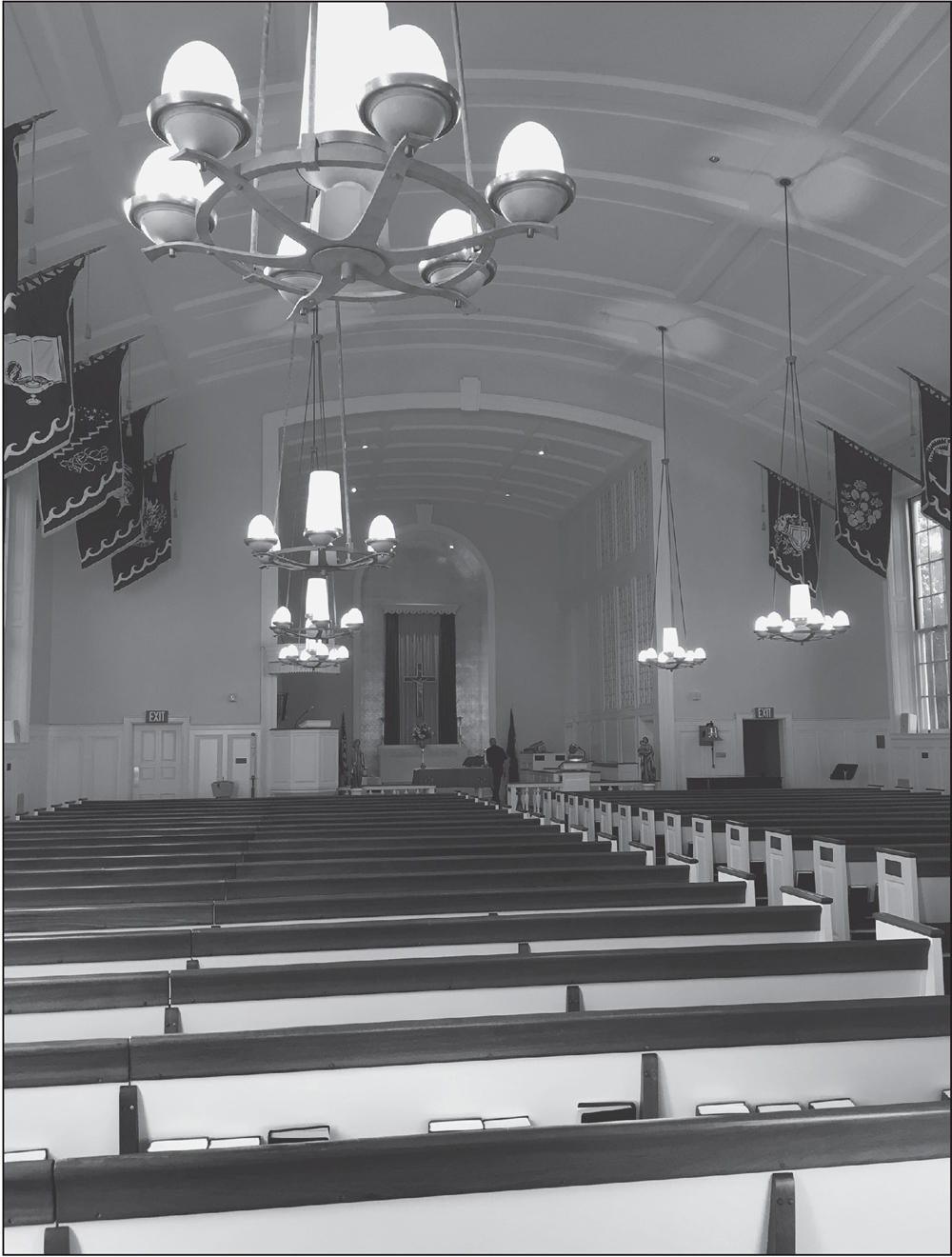
INTERIOR OF THE CHAPEL. The chapel was authorized by Congress on July 21, 1947, with the provision that it be funded by public subscription. A nationwide drive was launched in October 1948. The smallest donation was one cent, and the largest was $172,000, which was donated by the A.W. Mellon Educational and Charitable Trust; Mellon served as the secretary of the treasury from 1921 to 1932. The pews are made of solid mahogany and birch and can seat 480 people. (Author’s collection.)

































